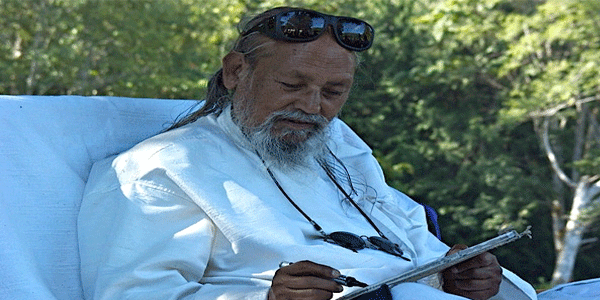Work
In 1952, Baba Hari Dass took a continual vow of silence called mauna (or maunavrata). In a similar tradition of Buddhist meditative method of Vipasana, silence is used “as the process of self-purification by introspection.”
In 1964, Bhagavan Das (yogi) met Baba Hari Dass near a temple called Hanuman Girdi, in Nainital, and later wrote: “The sadhu was a muni, a yogi whose practice of austerity includes complete silence. For the previous twelve years, whenever he wanted to communicate, he would jot his thoughts succinctly on a small chalkboard.” Similarly, in 1967, Ram Dass: “He is a jungle sadhu. He went into the jungle when he was 8 years old. He is silent (mauna). He has been mauna for 15 years. He writes with a chalkboard.”
Even as continued silence would seem a radical but also inconvenient form of communication, several Western authors recognized the social value of silence. Among those were Jacques Derrida and Søren Kierkegaard. In their view, silence would function as a precursor for clearer and substantively deeper understanding. Michael Strawser (Assistant Professor of Philosophy at the University of Central Florida), commenting on Jacques Derrida’s view of Soren Kierkegaard’s meaning of silence, wrote, “What is needed is Kierkegaard’s call to silence in order to recognize one’s responsibility to the other.” Silence is also valued by Perkey Avot, in the Jewish Sages guide for living, and functions as “a safety fence for wisdom”.
- Life
- Achievments
- Works
- Audio/Video
- Publication
For more details about Baba Hari Dass visit the more links….
1 2 3 4 5
 पौराणिक कथाओं, प्रेरक क्षण, मंदिरों, धर्मों, फिल्मों, हस्तियों के बारे में दिलचस्प जानकारी, हजारों गाने, भजन, आरती के बोल हैं Your wish may come true today…
पौराणिक कथाओं, प्रेरक क्षण, मंदिरों, धर्मों, फिल्मों, हस्तियों के बारे में दिलचस्प जानकारी, हजारों गाने, भजन, आरती के बोल हैं Your wish may come true today…




























